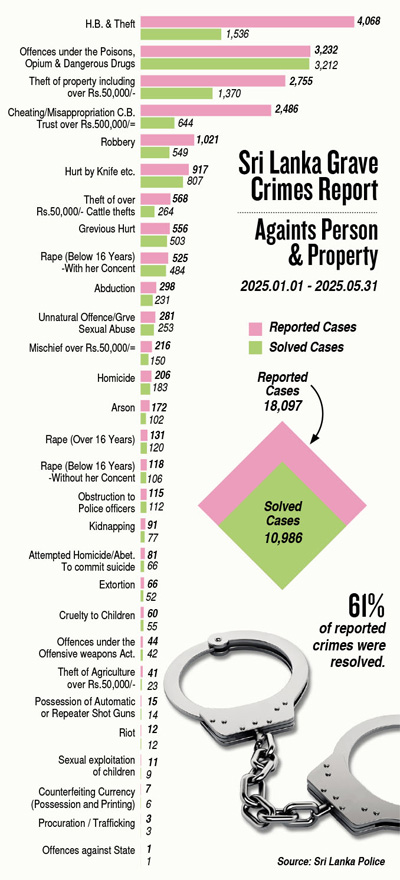News
Economically driven, drug-related crimes dominate crime statistics
View(s):By Minaza Hassan
About 10,000 incidents of crime committed during the first six months of the year are economically motivated, and over 3000 offences came under the Poisons, Opium & Dangerous Drugs Ordinance, the statistics show. They highlight that economically driven crimes also have a lower clearance rate compared to drug-related crimes, which stand out as highly reported and highly resolved crimes.
Many property-related and financially motivated crimes, such as housebreaking and robbery, are often committed “by drug users trying to find even a little money,” said Acting Police Media Spokesman Fredrick Wootler.
To address the issue, police patrols have been increased and district-level public security committees appointed, while most offenders are being sent for rehabilitation, he said.
There were about a thousand knife-assault-injury cases and more than 500 cases of grave harm, indicating that such crimes are becoming increasingly common.
The statistics also record about 200 cases of arson and nearly 100 cases of homicide and abetment to commit suicide during the period under review.
Nearly 400 cases of abduction and kidnapping were also reported.
“Many of the violent crimes are linked to organised crime groups (OCG), particularly drug-related gangs. These groups often clash over control and money, making these crimes highly competitive and violent. But the police have taken firm action, and many of those responsible are now behind bars,” ASP Wootler said.
The report indicates that sexual offences, particularly against minors, are alarmingly high, with over six hundred incidents of child sexual abuse and more than a hundred incidents of sexual violence against persons above the age of 16 reported.

The ASP said that to deal with the disturbing rise in sexual offences, dedicated Women’s Bureaus in police stations have been advised to handle the cases discreetly without retraumatising and revictimising women and girls who come forward to make complaints. These units are often led by senior female officers; many of them are mothers themselves who sympathise with the victims and handle the complaints seriously and sensitively to ensure the suspects are brought to justice, the acting police spokesman said.
“However, lawyer and social justice activist Jerushah Thambiyah said that despite adequate legal provisions, the persistent culture of victim shaming and the lack of sensitivity in how victims are treated in society continue to discourage many from reporting sexual offences.
As first responders, the police, lawyers and the judiciary must be trained to handle cases of sexual violence with caution and sensitivity, Ms. Thambiyah said.
She also called for the setting up of a separate court to fast-track cases of sexual offences, as the longer time the normal courts took to resolve a case not only discouraged victims from reporting but also prolonged the victim’s emotional distress.
Feminist researcher and consultant Saritha Irugulbandara said many victims expressed interest in seeking legal recourse but often feel hesitant or uncertain about approaching law enforcement. As a result, they are more likely to turn to non-governmental organisations (NGOs) for initial support, she said.
While most crimes have recorded a spike, it is encouraging to note that cases of child cruelty have declined. The report also reveals only three cases of child trafficking.
Poverty, economic inequality, unemployment and other social factors may contribute to the large number of economically driven and drug-related crimes, said criminologist and Dean of the Faculty of Criminal Justice at Kotelawala Defence University (KDU), Dr. Anusha Edirisinghe.
Commenting on the latest crime statistics, he explained that the lack of supervision and simply the opportunity to commit a crime may sometimes contribute to and invite criminal behaviour. Therefore, one way to reduce crime is to reduce opportunity for it to occur.
The awareness of legal consequences, the visibility of public surveillance, and the potential for social consequences can all play a role in shaping this environment, Dr. Edirisinghe said, adding that fear could also influence both the judgement and the likelihood of committing a crime.
Social norms and learned behaviour also play a role in shaping patterns of crime. For instance, compared to urban areas, crime is more common in slums, said Dr. Edirisinghe, highlighting how factors such as the social norms, lack of surveillance, and thereby greater opportunity to engage in criminal behaviour may influence criminality.
These explanations outline what criminologists like Cohen and Felson describe in their Routine Activity Theory, where crime arises when a motivated individual encounters a suitable target in the absence of effective guardianship. When structural pressures, environmental opportunities and social conditionings intersect, the likelihood of criminal behaviour can also increase.
The best way to say that you found the home of your dreams is by finding it on Hitad.lk. We have listings for apartments for sale or rent in Sri Lanka, no matter what locale you're looking for! Whether you live in Colombo, Galle, Kandy, Matara, Jaffna and more - we've got them all!

